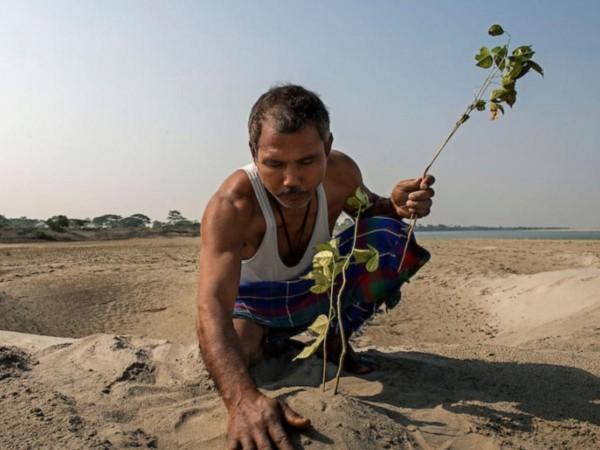Today, if hundreds of dead snakes were found on the drought-stricken banks of Majuli Reserve, the world's largest river island located in the Brahmaputra river, there would be a lot of noise around the environmental issue, followed by social media activism and prime time debate.
But the sight of dead snakes had a very different effect on then 16-year-old Jadav Molai Payeng. He knew somebody had to do something and then quietly went about doing it - one tree at a time.
In 1979, he started planting a sapling a day in the barren soil. Now over four decades later, his forest area covers a whopping 1,390 acres. Figuratively translated, that's much more than the size of Central Park in New York.

If education means being empowered and being able to make a difference, then Payeng was already on the right track. He dropped his formal education to give his undivided time and attention to the environment and the forest, in particular.
Payeng started by initially planting bamboo trees, but soon after moved on to other species. As the forest grew, so did the flora and fauna inhabiting it. Soon enough, his forest was filled with birds, deer, rhinos, peacocks, tigers and even included a herd of elephants straying into the forest for a few months every year.
Rewards and applause are all the more well-deserved when they are not pursued at all. When Payeng started out, little did he expect either of them to come his way. It was just the intention to do something before it was too late. The title The Forest Man of India was conferred on him in Delhi by the Government of India on World Earth Day in 2010. After all, he had turned a barren land of 550 hectares into a dense forest reserve stretching to 1300 acres all by himself. It took close to thirty years for the land to turn into a forest as it is today. And 65-year-old Payeng continues to plant even to this day.

From Assam to Mexico
Having done his lot in India, he is now working with the Mexican Government on a massive plantation project. In the numerous lectures, seminars and talks on the environment that he continues to attend across the world, he cannot emphasize enough the importance of inculcating this habit when a child is young.
"We must teach young children the importance of planting trees around us. This inculcation must start in school, at homes and we must catch them early," he has said in far too many interviews.
Jadav is a case study in ecology classes at schools, an inspirational story at motivational lectures and has had a children's book named after him, titled "Jadav and the Tree Palace." But mainstream accolades didn't happen until 2007 when a journalist walked into his forest and wrote about Jadav planting a sapling. He was awarded the Padma Shri in 2015. His biggest fear comprises human beings and human greed clouding the judgment; deforestation and other long-term damage happening for short-term gains.
In December of last year, Jadav signed an agreement with NGO Fundacion Azteca to collaborate on environmental projects in Mexico. The project aims at planting 7 million trees in the North American country. Not a big number, considering several estimates put the number of trees planted by him somewhere around 40 million in a span of thirty years.
If we were to monetize his contribution
Molai Forest, as it is now called, attracts 80 percent of the world's migratory birds as per wildlife experts. "The birds, cows, deer, wind, water and elephants have helped me," downplaying his contribution, Jadav said in an interview with The Hindu last year. Tough as it might be to monetise his contribution, but in a materialistic world, that's a language readily understood.
The value of each tree is Rs 75 lakh: SC
The value of a tree, if it has hundred years of lifespan left would be Rs 75 lakh. The value calculated, takes into account the innumerable benefits of a tree to mankind, its surroundings and the environment. It also takes into account the cost of oxygen the tree would emit into the atmosphere, the Supreme Court said in a judgment delivered earlier this year.

Following a PIL, a bench headed by CJI Bobde had set up a committee to quantify the true value of a tree. The PIL challenged the West Bengal government's decision to axe 356 trees to construct railway overbridges.
The first time ever an intrinsic value of a tree was calculated was biologist Professor TM Das. Published in the Indian Biologist in the year 1979, his research paper calculated the value of a tree, during its lifespan of 50 years, at $196,250 at the market rate prevailing in 1979. The same year that Jadav Peyang started planting his saplings.
His invaluable contribution to the environment is far higher if compared to any donation in monetary terms. And if it were to be ever monetized itself, will run into an astronomical figure of 40 million into Rs 75 lakh. We would have already had the world's first trillionaire in our midst.

















